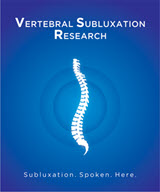Foundation for Vertebral Subluxation Involved in Research on Heart Rate Variability

The Foundation for Vertebral Subluxation (FVS) announced that recent research it supported was published in the Chiropractic Journal of Australia.
The new study conducted by Amy Haas DC, Ph.D and Dave Russell DC, reveals that chiropractic may play an important role in improving heart rate variability which is a critical measure of neurological and cardiovascular health.
The research, which was reviewed for human subjects protection by the FVS, includes a discussion of the literature supporting the utility of chiropractic care for health outcomes beyond just musculoskeletal improvements.
“Research is revealing that there is a relationship between abnormalities in the spine, the nervous system, stress and cardiovascular health” stated Dr. Matthew McCoy, a chiropractor, public health researcher and Vice President of the Foundation for Vertebral Subluxation. “Basic science research shows that the proper development and function of the nervous system relies on proper structure and movement of the spine from an early age.”
Research has shown not only that normal structural alignment and joint movement is crucial, but that complex neurochemical communication and pathways involved in helping humans to develop normally are tied into spinal biomechanics and their related neurological pathways.
“We are now seeing more and more basic science and clinical research showing the relationship between abnormal spinal function and the diagnosis of all types of health challenges” McCoy added. When it comes to cardiovascular health, the nervous system is often overlooked and that is where HRV comes into play.
According to Dr. Christopher Kent, who is President of the Foundation for Vertebral Subluxation and presented the preliminary findings of the study at the 2016 International Research and Philosophy Symposium (IRAPS) at Sherman College of Chiropractic, “In a healthy organism, higher heart rate variability represents greater adaptability to stress from its internal and external environment. When the nervous system is free of obstructions, it can better regulate anatomic, physiologic, and biochemical alterations and adapt to stress as needed.”
The Haas study reported on 6 patients undergoing chiropractic care who were examined and significant structural shifts in their spines were found. These structural shifts, more commonly known as vertebral subluxations by doctors of chiropractic, result in nerve obstruction and doctors of chiropractic correct these obstructions.
The patients underwent chiropractic care from 3 months to over 2 years and experienced sustained improvement in HRV over their course of chiropractic care that is consistent with improved health outcomes. The study showed objective, non-musculoskeletal outcomes that were consistent with neurophysiological effects associated with reduction or resolution of vertebral subluxation including improvements in coherence, spinal biomechanical function, neurological function, resilience, and adaptability.
This latest study comes on the heels of two other recent studies on heart rate variability and its relationship to vertebral subluxation involving the FVS.
A study by Knowles and Kotur, in the Annals of Vertebral Subluxation Research reported on 46 patients undergoing chiropractic care who had their heart rate variability (HRV) measured before care and then again after 90 days of care. The patients had chief complaints that ranged from musculoskeletal to visceral, while others were asymptomatic.
Similar to the Haas study, the subjects were examined for vertebral subluxations and after extended care it was demonstrated that chiropractic care was an effective method for people to improve their nervous system function through adjustment of vertebral subluxation. The authors of that study stated removal of these obstructions reorganizes spinal tension patterns and decreases physiological stress.
In another paper reviewing the literature on heart rate variability published in the journal Research & Reviews: Neuroscience, FVS’s President Christopher Kent DC, JD did a search of the relevant literature addressing heart rate variability and the reduction or correction of vertebral subluxation from 2000 to 2017 and summarized the results. Kent concluded that heart rate variability is a reliable and valid tool that may be used to assess the changes in autonomic activity associated with the reduction and correction of vertebral subluxations.
According to Haas, “Future directions for HRV research in the chiropractic research arena should include expanding upon the current research using a sample size large enough for statistical analysis and longitudinal study, exploration of potential effects of the chiropractic adjustment on EEG activity of cardiac and cardiac-related nuclei, and exploration of whether sensory input generated by the chiropractic adjustment may affect nuclei in the medulla in a way that directs HRV changes.”
The Foundation for Vertebral Subluxation has several other studies on HRV underway or in the planning stages.
CLICK HERE to review the Haas study
CLICK HERE to review the Knowles study
CLICK HERE to review the Kent study
CLICK HERE for more information about the FVS
Contact Information:
Matthew McCoy DC, MPH
Vice President
Foundation for Vertebral Subluxation
http://www.vertebralsubluxation.org
drmatthewmccoy@gmail.com
Blogs
- The Chiropractic Cartel: A Look Back at Bias in Accreditation and its Imact on Today's Profession
- Inside Montana's Chiropractic Monopoly: ACA & MCA's Brazen Board Takeover
- Concerns Grow About Control of the NY State Chiropractic Board by the ACA - Use of X-ray in NY Under Threat
- Reproductive Health Information and Chiropractic Care: Navigating New Privacy Regulations
- Navigating Substance Use Disorder (SUD) Consent: What Chiropractors Need to Know














